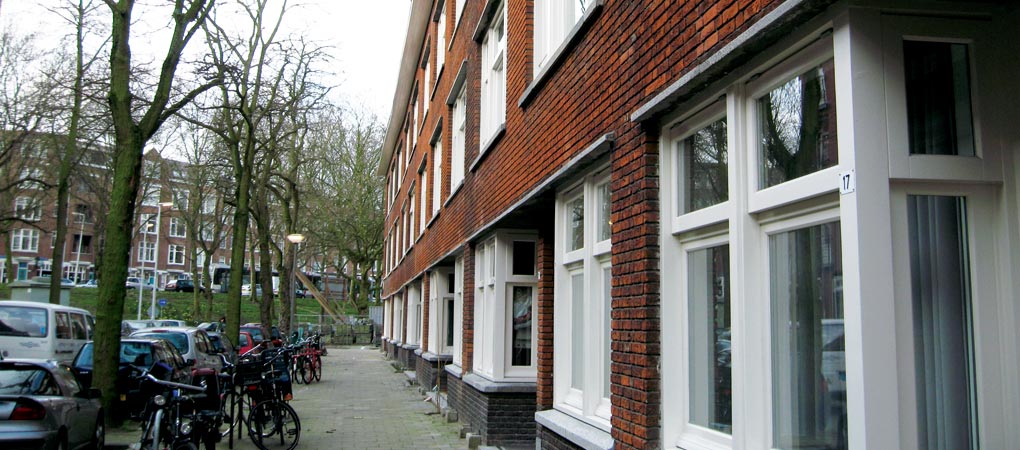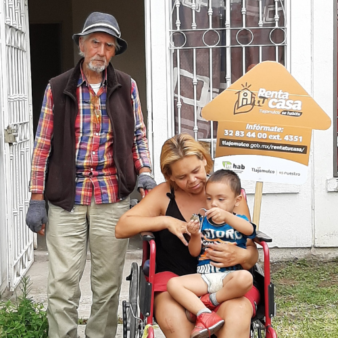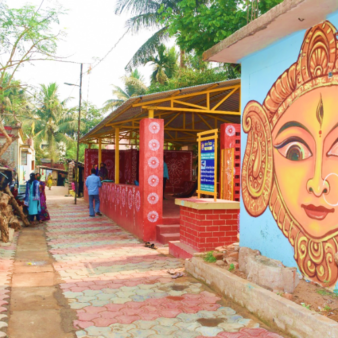In order to address the severe social and economic problems in the Spangen neighbourhood of the city, Rotterdam Development Corporation decided to give an old apartment block away for free, on condition that the new owners met the cost of renovation of the architecturally valuable building and continued to live in the area for two years. Young local professionals, who could not afford to buy a house, were given priority. The average cost for the 40 participating households was US$183,000 and the work has acted as a trigger for local regeneration. Other cities are now using the same approach.
Project Description
Aims and Objectives
- To improve the image and interest in Spangen neighbourhood, Rotterdam and attract young urban professionals to an area with severe social and economic problems.
- To provide affordable housing for young people who would have no chance to own their own home in the city otherwise.
- To renovate architecturally valuable buildings typical of the 1930s.
Context
Rotterdam is the second city and the industrial heart of the Netherlands, as well as being the economic, social and cultural centre of the Rijnmond (‘Rhine Estuary’) region. More than one million people from 162 countries live in the Rotterdam region. The port of Rotterdam is the largest in Europe and was the world’s busiest port from 1962 to 2004, when it was overtaken by Shanghai.
Originally famous for its urban design and architectural heritage, the Spangen neighbourhood in the west of the inner city of Rotterdam is now one of the poorest urban neighbourhoods in the Netherlands. It has experienced severe deprivation over many years, with multiple problems of abandoned and run-down properties, drug abuse, slum landlords and prostitution. It has many inhabitants with low incomes and a high percentage of social housing. Spangen has a population of approximately 9,000, 87 per cent of whom are migrants (primarily Turkish and Moroccan). It had become one of the city’s drug dealing centres and was recognised as a ‘no-go’ area in the early 1990s and violence regularly flared up because of growing tensions in the area.
Project details
Built in the 1930s, the dilapidated Wallisblok building on the banks of the River Schie in the Spangen area of the city had many attractive features, although it had suffered severe subsidence, due to its rotting foundations. The building had originally included 96 individually owned apartments, many of which had been sold to the City authorities years ago and had been empty ever since. These empty apartments had sometimes been used by drug abusers and prostitutes and the City had put up large steel barriers to try to prevent this, thereby adding to the unattractiveness of the neighbourhood. Many of the remaining apartments were owned by slum landlords, renting the small rooms to large numbers of illegal immigrants. The City authorities purchased the remaining apartments that they did not already own and any tenants were provided with alternative accommodation elsewhere in the city. Existing owner occupiers were given the option of becoming part of the project and six chose to do so. Although renovation was preferred to demolition, this was too expensive for the city to undertake itself. It was decided that the only way to carry out the renovation was to use the legal form of Collective Private Assignment – selling the houses before renovation to a group of buyers who agreed to renovate it together.
In order to attract people willing to invest in this part of town, the city decided to give the houses away for free, on condition that the new owners met the cost of renovation. Preference was given to young professionals already living in the city, who could not afford to buy a house. Requirements were placed on the sale that the building had to be renovated to high quality residences and that the new owners had to live in their flat for at least two years and they should not rent it out.
The prospective residents came together two years before they moved in and during this time formed into a homogeneous group, having organised many meetings to discuss issues relating to design, planning, costs etc. Each resident participated in one or more of the working groups. The building group, for example, worked closely with the architects and made proposals for the new interiors and checked the drawings of the architect. Another group invested time in searching for the best deals with banks for mortgages, while others physically worked in the garden to empty and clean it.
Although the architecturally valuable exterior was preserved, the rear façade and interior were removed and the prospective residents designed their new homes to fit their own personal preferences. The 96 small apartments were turned into 40 new ones, all of them different. Bringing a group of young people with higher income than average to the area has given a positive boost to the neighbourhood, as well as restoring the physical fabric of the area.
Covering costs
The City purchased the building when it became apparent that the existing owners were not willing to carry out the renovation work. The total cost to the municipality was €4,700,000 (US$6,904,000), of which 79 per cent was for the acquisition of the building and the remainder of the cost was for the repairs to the existing foundations and relocation expenses for tenants who were provided with alternative accommodation. Comparative costs of renovation and demolition/rebuilding were investigated and although the cost of renovation was more expensive by €400,000 (US$588,000), it was felt to be worth it in order to preserve a valuable building.
The cost of renovation was €5,000,000 (US$7,320,000) and this was shared amongst the 40 households that participated, thereby making it affordable at an average cost of €125,000 (US$183,000). Costs were allocated under the Collective Private Assignment system. This is a comparatively new legal mechanism in the Netherlands, facilitating collective renovation. Some of the costs were allocated to residents on a per m2 basis (to reflect the different size of the flats), such as work on the exterior facades; other costs were allocated by household, such as the communal garden costs. Individual households arranged their own mortgages, although one particular bank (Rabobank) offered discounted interest rates for households involved with the project.
Impact
- Renovation of an old dilapidated area of the city is now beginning to happen, partly as a result of the very positive publicity surrounding this project and the young people involved in the renovation of one of the key buildings in the area.
- The residents live in affordable homes that they have been able to design specifically to meet their individual needs. They have formed strong friendships with the other residents and have a commitment to improving the area where they are living.
- The inhabitants in the area see and feel the change in their neighbourhood and more and more people now want to live in Spangen, reversing the previous trend of people trying to leave the neighbourhood.
- The city of Rotterdam is using the approach in other parts of the city.
- The project has encouraged other renovation projects in the area, as well as attracting a range of other activities including restaurants, cafes and artists.
Why is it innovative?
- Giving the houses away for free (650 people came to the first information meeting).
- The building block was renovated under the authority of the future inhabitants without the intervention of a property developer, which led to the development of unique dwellings.
- A group of very enthusiastic people came together to make the project happen (residents, city employees and the architects).
What is the environmental impact?
The conversion of an existing building to provide the 40 apartments created through this project has reduced the need for new construction materials. Much of the rear façade and the interior construction were replaced but wherever possible existing building materials were recycled and used in the renovation.
Environmental standards applied throughout the renovation have been higher than the existing Dutch requirements. A grant was received from the city authorities in respect of the high levels of insulation achieved in the conversion.
The new communal gardens that have been created in the former concrete courtyard have added to the overall improvement of public space taking place in the Spangen district that has included the renovation of the small park areas that had been included in the original design of the area.
Is it financially sustainable?
This project requires no future revenue funding. Future projects will still require initial support from the city authority to purchase the property. The success of the approach has been shown in the extent to which the allocation was oversubscribed and the city authority is now looking to charge a small amount rather than give the houses away for free in the future.
- The wealth of the local community in the Spangen area has increased as the area begins to be improved and there is a greater range of economic opportunities in the area.
- Property values have increased in the area, as well as increased occupancy and the city authorities have therefore increased their income from property taxes in the area.
- As with many other large European cities, it was virtually impossible for young people to afford to buy a house in any of the city neighbourhoods. The DDV project enables them to have an affordable home, at an approximate cost of €125,000 (US$183,000), plus a considerable input of time spent in designing, guiding and organising the renovation process.
- It is not anticipated that the area will undergo a rapid gentrification process, since it contains a range of housing provision, including social housing, private rental housing and owner-occupied housing.
What is the social impact?
Working together to bring the project into being, creating not only their own apartments but also collaborating to create and plant the communal garden, encouraged strong social cohesion amongst the group of prospective residents. This has inspired many of them to get involved in a range of activities in the local community pursuing initial links provided by existing residents who have remained in the building.
The young residents have acquired a wide range of skills as they have managed the project, working with the architects on the design and preparing detailed financial plans. The residents of this first renovated block are supporting other groups and individuals who are entering into the same process in other parts of the city.
Spangen, previously regarded as an area rife with potential for violence and crime, has significantly improved its position based on the score that the City uses to assess safety for different parts of Rotterdam. On the scale of zero to ten, where ten is excellent, Spangen has moved from a score of four to a score of seven. The greater social and economic mix in the area combined with a safer neighbourhood, good quality accommodation and access to open space in the communal gardens has provided a positive and healthy living environment.
Barriers
- Building regulations, particularly with respect to fire, limited the scope for what residents could do with the internal layout and design of their apartments.
- A large number of meetings were necessary over the two-year development period and it was difficult for some of the households to make the time commitment necessary.
- Taxes with respect to purchase of the properties related to the future value of the development, rather than the zero value for which the apartments had actually been purchased.
Lessons Learned
- The architectural professionals involved realised that there is no limit on the various options/preferences that people have in respect of the layout and design of their living accommodation, but with cooperation and discussion the various needs and wishes can be accommodated.
- The collaborative working method developed by the residents and architects in the project demonstrated that it is possible to renovate a dilapidated block without the intervention of a housing company.
- It is possible to design every apartment individually and for it still to be affordable.
- One relatively small project can actually make a big difference in how an area is perceived and the wider population’s attitude towards it.
Evaluation
Post-occupancy evaluation studies are being carried out with the residents.
Transfer
Following the success of this project, the idea of collective private renovation has been introduced in other parts of the city, primarily in poor neighbourhoods that were experiencing social problems. The city has obtained a further 169 apartments which have been renovated through 2007. A third group of properties is currently being advertised. The do-it-yourself house has become very popular and demand consistently exceeds supply. The approach has also been used for individual properties on the same basis.
On a national scale, the city of The Hague has started a similar project offering 125 houses for purchase on a DIY basis.



